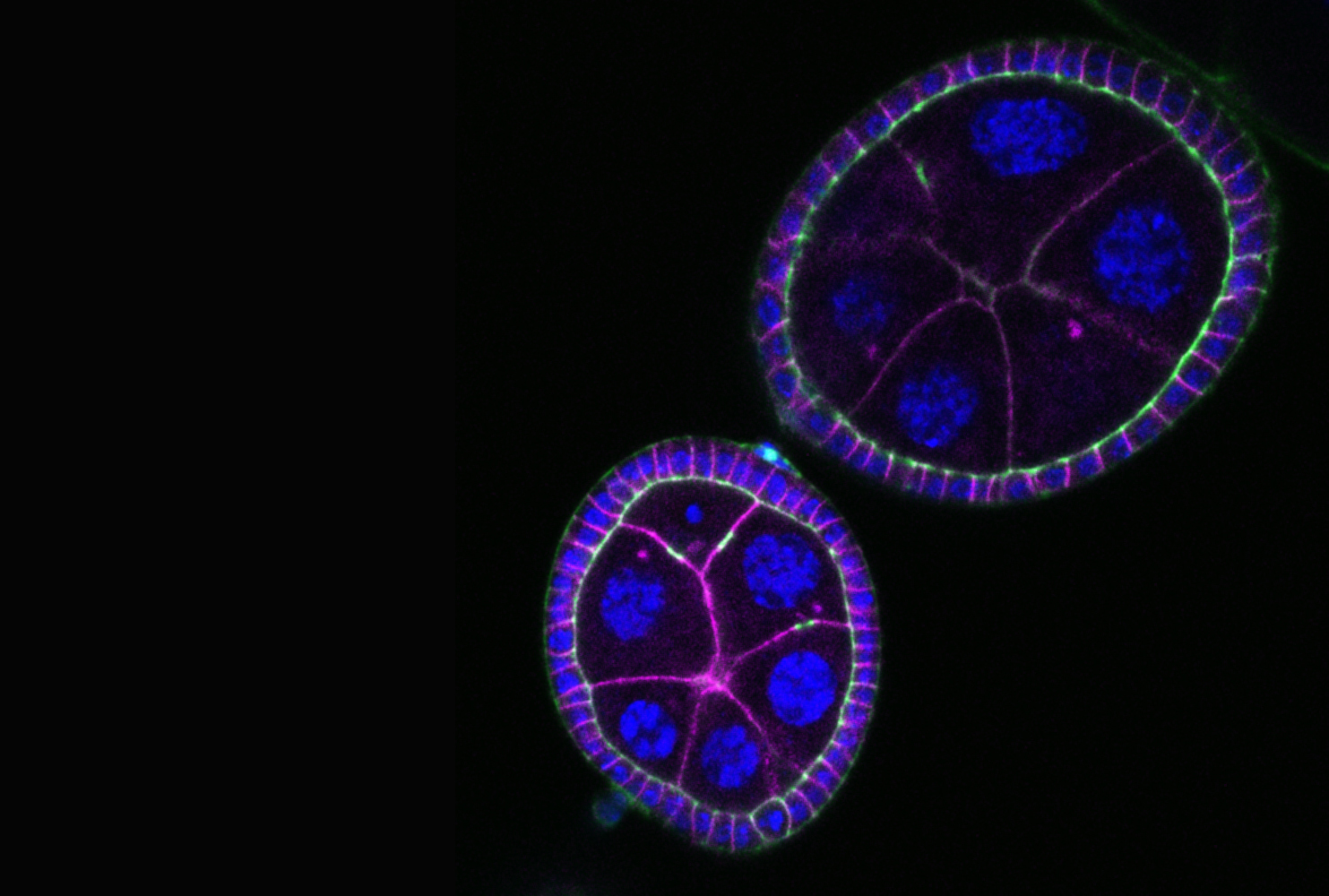Epithelial Polarity & Cell Division
ABOUT
Epithelial tissues play fundamental roles as the cohesive and selective barriers that compartmentalize animal life. A critical property of epithelial cells is their ability to establish molecular asymmetries along an apical-basal axis. This apical-basal polarity is so inseparable from epithelial function that its disruption has dramatic consequences for organism development and is also linked to human pathologies, including cancer. Our overarching goal is to understand how apical-basal organization is dynamically coordinated with cell division to preserve epithelial function during organ growth, development and homeostatic proliferation. The team of J. Ferreira follows an independent line of research to address how cell and nuclear mechanics ensure chromosome segregation fidelity in epithelial cells, in order to avert aneuploidy.
RESEARCH
By uncovering new cellular and molecular mechanisms that preserve epithelial function and genome ploidy, we aim to elucidate two critical aspects of multicellular life, while providing new mechanistic insight to tackle disease. We currently address the following main questions:
- How to remodel apical-basal organization to propagate epithelial architecture and maintain cohesion during cell division?
- How to make cytokinesis a polarized and efficient process in epithelial tissue?
- How to switch on/off apical-basal polarity?
- How to coordinate polarity with cytoskeleton reorganization to drive collective cell migration?
To dissect epithelial dynamics at the organism level, we perform high-resolution microscopy in Drosophila tissues, taking advantage of the conservation of molecular mechanisms controlling apical-basal organization. Moreover, we are expanding the experimental tractability of Drosophila genetics (RNAi, mutants, CRISPR) with new optogenetic tools that enable high temporally-controlled in vivo and ex-vivo perturbations. These are complemented with biochemical and mechanical approaches as well as mammalian cell culture models, which we are establishing with our network of collaborators and recent funding (FCT - PTDC/BIA-CEL/1511/2021).
Our recent work has revealed new mechanisms that 1) ensure the dynamic behaviour of epithelial apical-basal organization (Ventura et al., Development, 2020); 2) transmit epithelial organization during cell division (Moreira et al., Cell Rep, 2019; di Pietro et al., Curr Biol, 2023); and 3) regulate epithelial cell shape and maintain epithelial barrier integrity during proliferation (Osswald et al., Curr Biol 2022). To address our research questions, we have implemented new approaches to manipulate protein function with high temporal control using optogenetics (Zeng et al., Nat Struct Mol Biol 2021, Osswald et al., Curr Biol, 2022), and we have contributed to the development and characterization of a library of transgenic lines endogenously tagging all Drosophila RhoGAPs/RhoGEFs (di Pietro et al., Curr Biol, 2023). We also have ongoing collaborations to develop new Drosophila models to study genetic alterations identified in cancer patients (Figueiredo et al., Gastric Cancer, 2022; Faria et al., Dis Model Mech, 2023).

Team
Selected Publications
The Dystrophin-Dystroglycan complex ensures cytokinesis efficiency in Drosophila epithelia. EMBO Reports26(2):307-328, 2025. [Journal: Article] [IF: 6.2 (*)]
DOI: 10.1038/s44319-024-00319-y SCOPUS: 85209130602
di Pietro F., Osswald M., De las Heras J.M., Cristo I., López-Gay J., Wang Z., Pelletier S., Gaugué I., Leroy A., Martin C., Morais-de-Sá E., Bellaïche Y.
Systematic analysis of RhoGEF/GAP localizations uncovers regulators of mechanosensing and junction formation during epithelial cell division. Current Biology33(5):858-874.e7, 2023. [Journal: Article] [CI: 11] [IF: 8.1]
DOI: 10.1016/j.cub.2023.01.028 SCOPUS: 85149976826
Osswald M., Barros-Carvalho A., Carmo A.M., Loyer N., Gracio P.C., Sunkel C.E., Homem C.C.F., Januschke J., Morais-de-Sá E.
aPKC regulates apical constriction to prevent tissue rupture in the Drosophila follicular epithelium. Current Biology32(20):4411-4427.e8, 2022. [Journal: Article] [CI: 14] [IF: 9,2]
DOI: 10.1016/j.cub.2022.08.063 SCOPUS: 85140317779
Figueiredo J., Ferreira R.M., Xu H., Gonçalves M., Barros-Carvalho A., Cravo J., Maia A.F., Carneiro P., Figueiredo C., Smith M.L., Stamenović D., Morais-de-Sá E., Seruca R.
Integrin β1 orchestrates the abnormal cell-matrix attachment and invasive behaviour of E-cadherin dysfunctional cells. Gastric Cancer25(1):124-137, 2022. [Journal: Article] [CI: 24] [IF: 7,4]
DOI: 10.1007/s10120-021-01239-9 SCOPUS: 85114350265
Zeng J., Santos A.F., Mukadam A.S., Osswald M., Jacques D.A., Dickson C.F., McLaughlin S.H., Johnson C.M., Kiss L., Luptak J., Renner N., Vaysburd M., McEwan W.A., Morais-de-Sá E., Clift D., James L.C.
Target-induced clustering activates Trim-Away of pathogens and proteins. Nature Structural and Molecular Biology28(3):278-289, 2021. [Journal: Article] [CI: 67] [IF: 18,4]
DOI: 10.1038/s41594-021-00560-2 SCOPUS: 85101745267
Ventura G., Moreira S., Barros-Carvalho A., Osswald M., Morais-de-Sá E.
Lgl cortical dynamics are independent of binding to the Scrib-Dlg complex but require Dlg-dependent restriction of aPKC. Development147(15):, 2020. [Journal: Article] [CI: 15] [IF: 6,9]
DOI: 10.1242/dev.186593 SCOPUS: 85089300645
Moreira S., Osswald M., Ventura G., Gonçalves M., Sunkel C.E., Morais-de-Sá E.
PP1-Mediated Dephosphorylation of Lgl Controls Apical-basal Polarity. Cell Reports26(2):293-301.e7, 2019. [Journal: Article] [CI: 20] [IF: 8,1]
DOI: 10.1016/j.celrep.2018.12.060 SCOPUS: 85059397223
Osswald M., Morais-de-Sá E.
Dealing with apical–basal polarity and intercellular junctions: a multidimensional challenge for epithelial cell division. Current Opinion in Cell Biology60:75-83, 2019. [Journal: Review] [CI: 15] [IF: 8,2]
DOI: 10.1016/j.ceb.2019.04.006 SCOPUS: 85066055206
Carvalho C.A., Moreira S., Ventura G., Sunkel C.E., Morais-De-Sá E.
Aurora a triggers Lgl cortical release during symmetric division to control planar spindle orientation. Current Biology25(1):53-60, 2015. [Journal: Article] [CI: 65] [IF: 9]
DOI: 10.1016/j.cub.2014.10.053 SCOPUS: 84920415073
Morais-De-Sá E., Sunkel C.
Adherens junctions determine the apical position of the midbody during follicular epithelial cell division. EMBO Reports14(8):696-703, 2013. [Journal: Article] [CI: 73] [IF: 7,9]
DOI: 10.1038/embor.2013.85 SCOPUS: 84881480225
Morais-de-Sá E., Mirouse V., St Johnston D.
aPKC Phosphorylation of Bazooka Defines the Apical/Lateral Border in Drosophila Epithelial Cells. Cell141(3):509-523, 2010. [Journal: Article] [CI: 226] [IF: 32,4]
DOI: 10.1016/j.cell.2010.02.040 SCOPUS: 77951911203

